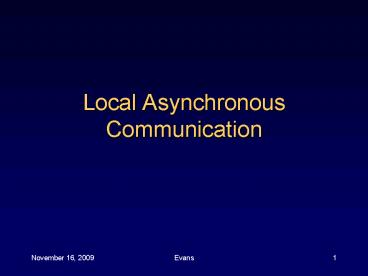Local Asynchronous Communication - PowerPoint PPT Presentation
1 / 21
Title:
Local Asynchronous Communication
Description:
Baud. Jean-Maurice-Emile Baudot (b. 1845, Magneux, France--d. March 28, 1903, Sceaux) ... Baud rate is the number of signalling events per second. A baud is a ' ... – PowerPoint PPT presentation
Number of Views:19
Avg rating:3.0/5.0
Title: Local Asynchronous Communication
1
Local Asynchronous Communication
2
Asynchronous
- Means untimed, unexpected
- Sender and receiver dont coordinate before
communication - Sender sends whenever
- Receiver must be ready to accept communication at
any point
3
Asynchronous Continued
- Good for lots of devices where data are generated
randomly - Pretty much anything from humans
- One possible scenario negative voltage for 1 and
positive for 0
4
Voltage Diagram
5
Need For Standards
- How long to keep voltage? How many times a
second? How much voltage? - Standards specify these in great detail
- Allows for interoperability
- Organizations
- ITU, EIA, IEEE, ISO, CCITT
6
Standards
- Documents created
- EIA created on for serial communication RS-232
- Sends characters serially
- Serial communication is one bit at a time
- Parallel is more than one
7
RS-232
- Sends data a character at a time
- Has start and stop bit to denote beginning and
end of character - -15 Volts
- Each bit same length
8
RS232 Picture
9
Baud
- Jean-Maurice-Emile Baudot (b. 1845, Magneux,
France--d. March 28, 1903, Sceaux) - Dont usually specify time per bit
- Instead bits per second
- Baud changes per second
- Not bits per second
10
Baud Continued
- A baud is a signalling event in which bits can be
encoded. Baud rate is the number of signalling
events per second. - A baud is a bucket that can hold a fixed number
of bits. - Receiver measures channel multiple times a bit
- Compares against valid bit time
- Errors are called framing errors
11
Simplex Et Cetera
- Simplex one direction only
- Half duplex one direction at a time
- Full duplex both directions at the same time
- Two wires needed to communicate
- Signal and ground
- One signal/ground pair can send in only one
direction - RS-232 needs three wires for full duplex
12
RS232 Full Duplex
13
RS-232 Connectors
- Data Communication Equipment (DCE)
- at the computer end
- Data Termination Equipment (DTE)
- At the serial device end
- These two have different transmit and receive
pins - So connecting to DCEs requires crossover cable
14
Limits
- Real hardware cannot perfectly transmit signals
distortion - Wires do not conduct perfectly
- Distance limits degradation of signal over space
15
Limits Picture
16
Bandwidth
- Non-perfect transmission limits overall rate
- Each medium has bandwidth
- Maximum rate at which hardware can change and
detect - Bandwidth measured in Hertz (Hz)
- 4000 Hz (4 kHz) 4000 changes per second maximum
- Bandwidth is a measure of the width of spectrum a
transmission medium can carry and deliver - The range of frequencies the hardware can carry
17
Bandwidth Continued
- Nyquists sampling theorem gives theoretical
upper limit to amount of information transmitted
based on bandwidth - Bandwidth B
- K possible values of voltage in each unit of
transmission - 2?B?log2K (note log2X (ln(X) / ln(2)) )
18
Bandwidth Continued
- Nyquist doesnt address noise
- Shannon limit does
- B?log2(1 S/N)
- Signal to noise ratio
- Measured in decibels (dB 10log10(S/N))
- 20 dB x100
- 3000?log2(1 1000) 30,000 bps
19
Frequency Spectrum
20
Example Calculations
- Review logs
- Nyquist Max data rate D 2Blog2(K)
- K 8 23, B 3000 Hz, can transmit D
230003 18000 bits per second (each
half-cycle can encode 3 bits) - Shannon Channel Capacity (bits/sec) C
Blog2(1S/N) - Signal level actually in S/N in a measure called
decibels - db 10log10(S/N)
- S/N 100 gives 20 db
- S/N 1000 gives 30 db, whats 40 db?
- Given BW 3000 Hz, 40 db signal (S/N 104
10000) - C (3000)log2(10001) ? 39800 bits/sec. Try 20
db?
21
Problems
- Given bandwidth of 4000 Hz, with K 8 levels of
energy sent in each baud, what is the maximum
theoretical bit transmission rate? - Given bandwidth of 4000 Hz, we send a 50 db
signal. What is the actual channel capacity? - What if it was 60 db?































